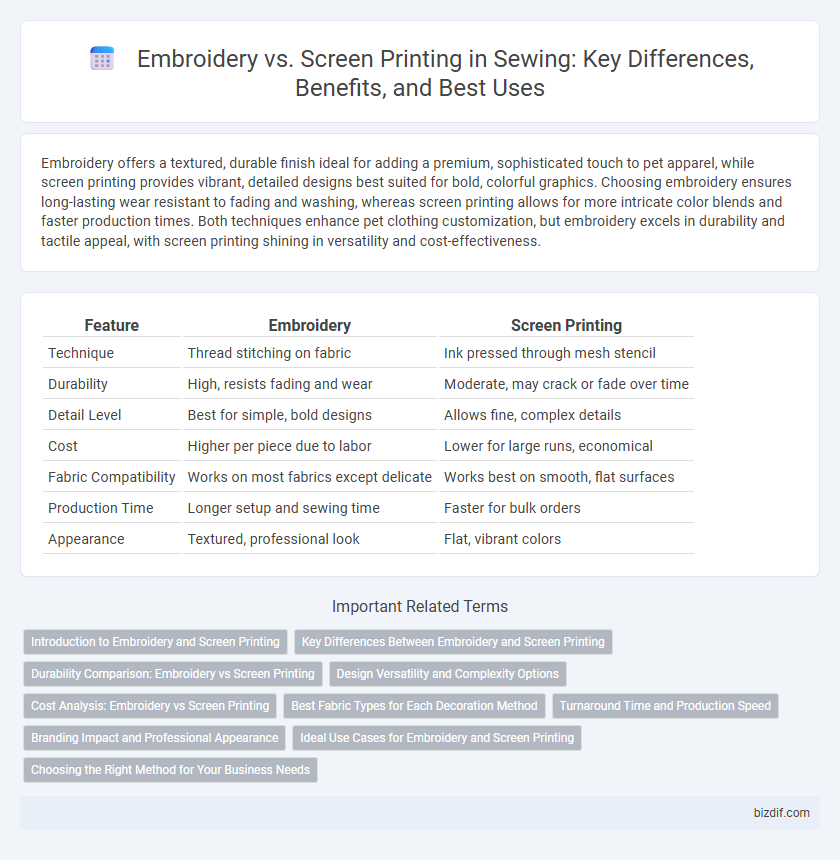Embroidery offers a textured, durable finish ideal for adding a premium, sophisticated touch to pet apparel, while screen printing provides vibrant, detailed designs best suited for bold, colorful graphics. Choosing embroidery ensures long-lasting wear resistant to fading and washing, whereas screen printing allows for more intricate color blends and faster production times. Both techniques enhance pet clothing customization, but embroidery excels in durability and tactile appeal, with screen printing shining in versatility and cost-effectiveness.
Table of Comparison
| Feature | Embroidery | Screen Printing |
|---|---|---|
| Technique | Thread stitching on fabric | Ink pressed through mesh stencil |
| Durability | High, resists fading and wear | Moderate, may crack or fade over time |
| Detail Level | Best for simple, bold designs | Allows fine, complex details |
| Cost | Higher per piece due to labor | Lower for large runs, economical |
| Fabric Compatibility | Works on most fabrics except delicate | Works best on smooth, flat surfaces |
| Production Time | Longer setup and sewing time | Faster for bulk orders |
| Appearance | Textured, professional look | Flat, vibrant colors |
Introduction to Embroidery and Screen Printing
Embroidery utilizes needle and thread to create textured, durable designs that enhance fabric with a three-dimensional effect, ideal for logos and monograms. Screen printing applies ink through a mesh stencil directly onto fabric, offering vibrant colors and sharp detail on various materials. Both techniques are essential in custom apparel, with embroidery favored for long-lasting embellishments and screen printing preferred for cost-effective, high-volume production.
Key Differences Between Embroidery and Screen Printing
Embroidery involves stitching thread directly into fabric, creating a textured and durable design ideal for logos and intricate patterns, while screen printing applies layers of ink onto the fabric surface, allowing for vibrant colors and detailed images. Embroidery typically offers greater longevity and a premium look, whereas screen printing is more cost-effective for large orders and complex color gradients. Fabric type and design complexity play crucial roles in choosing between these two methods for garment customization.
Durability Comparison: Embroidery vs Screen Printing
Embroidery offers superior durability compared to screen printing, as stitched threads resist fading, cracking, and peeling over time. Screen printing, while vibrant and cost-effective, tends to degrade faster with frequent washing and exposure to friction. Garments with embroidery maintain their design quality significantly longer, making them ideal for long-term use and high-wear applications.
Design Versatility and Complexity Options
Embroidery offers rich design versatility with intricate stitching techniques that create textured, durable designs ideal for logos and detailed artwork. Screen printing excels in handling complex, multi-color designs with gradients and photographic detail on various fabric types, providing vibrant and smooth finishes. Choosing between embroidery and screen printing depends on the desired design complexity and the tactile quality required for the finished garment.
Cost Analysis: Embroidery vs Screen Printing
Embroidery typically incurs higher initial setup costs due to digitizing designs and thread expenses, making it more cost-effective for small runs or custom details. Screen printing offers lower per-unit costs at high volumes but involves substantial setup fees for screens and color separations, making it ideal for large batch orders. Evaluating project scale and design complexity is crucial for determining whether embroidery or screen printing provides the best cost efficiency.
Best Fabric Types for Each Decoration Method
Embroidery works best on durable, tightly woven fabrics such as cotton twill, denim, and canvas, allowing threads to hold their shape and detail over time. Screen printing excels on smooth, stretchy textiles like polyester, nylon, and cotton blends, where ink adheres evenly for vibrant, long-lasting designs. Choosing the right fabric enhances the quality and durability of both embroidery and screen-printed garments.
Turnaround Time and Production Speed
Embroidery typically requires longer turnaround times due to the intricate stitching process, especially for complex designs with multiple colors. Screen printing offers faster production speeds, making it ideal for bulk orders with simple, flat images. Choosing between embroidery and screen printing depends on the urgency of delivery and the complexity of the design requirements.
Branding Impact and Professional Appearance
Embroidery offers a textured, high-quality finish that enhances brand perception through durability and a professional, upscale appearance ideal for corporate apparel. Screen printing provides vibrant color reproduction and cost-effective scalability, making it suitable for bold, graphic branding on a variety of fabrics. Choosing between embroidery and screen printing depends on the desired brand image, with embroidery conveying sophistication and screen printing delivering eye-catching visual impact.
Ideal Use Cases for Embroidery and Screen Printing
Embroidery is ideal for creating durable, high-quality designs on thicker fabrics like jackets, hats, and polos, making it perfect for corporate logos and athletic wear that require long-lasting detail. Screen printing excels at producing vibrant, cost-effective designs on large quantities of T-shirts, hoodies, and other lightweight fabrics, especially for colorful or complex artwork. For designs with intricate details and multiple colors, screen printing offers greater flexibility, while embroidery provides a premium, textured finish suited for professional and upscale branding.
Choosing the Right Method for Your Business Needs
Embroidery offers durability and a premium, textured look ideal for high-quality apparel and long-lasting branding, while screen printing provides vibrant colors and cost-effective bulk production suited for complex designs on a variety of fabrics. Small businesses targeting detailed logos or professional uniforms benefit from embroidery's lasting appeal, whereas startups needing quick turnaround and budget-friendly options often prefer screen printing. Analyzing order volume, design complexity, fabric type, and budget is essential to selecting the optimal method for business growth and brand representation.
Embroidery vs Screen Printing Infographic

 bizdif.com
bizdif.com